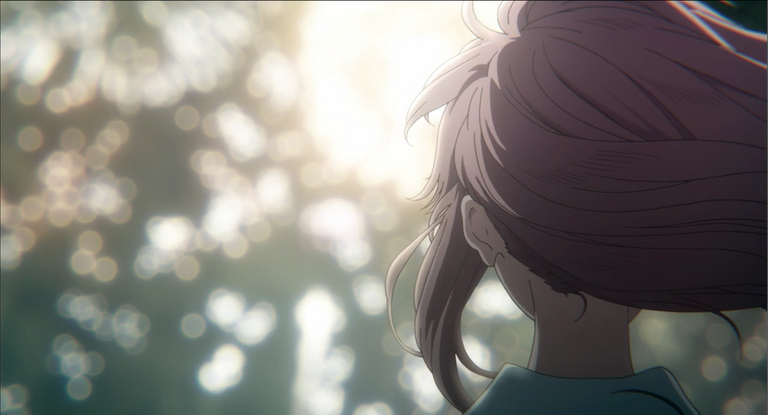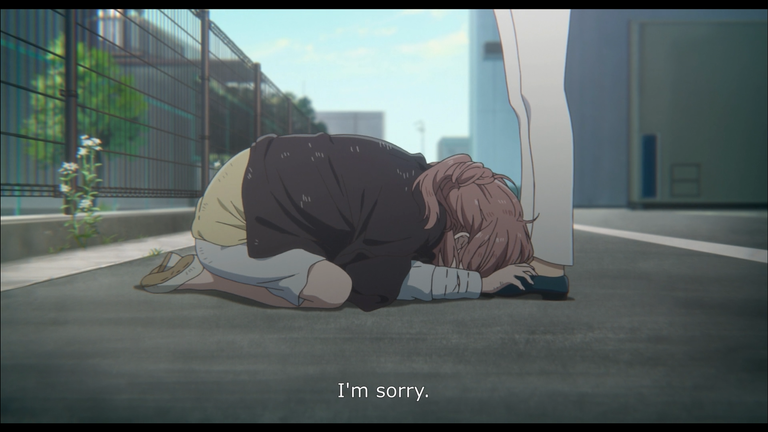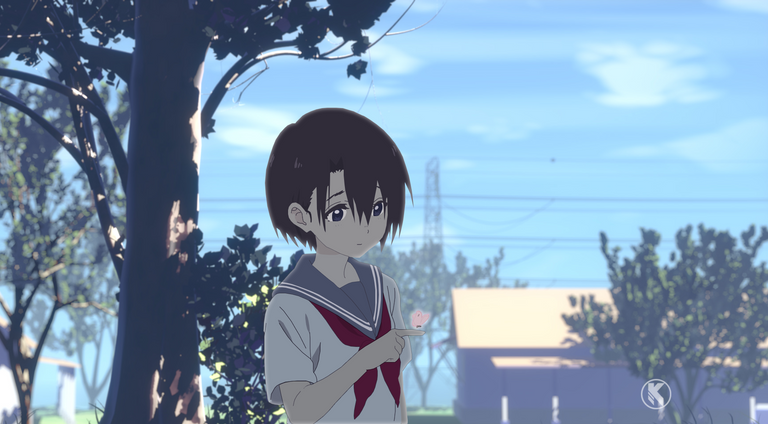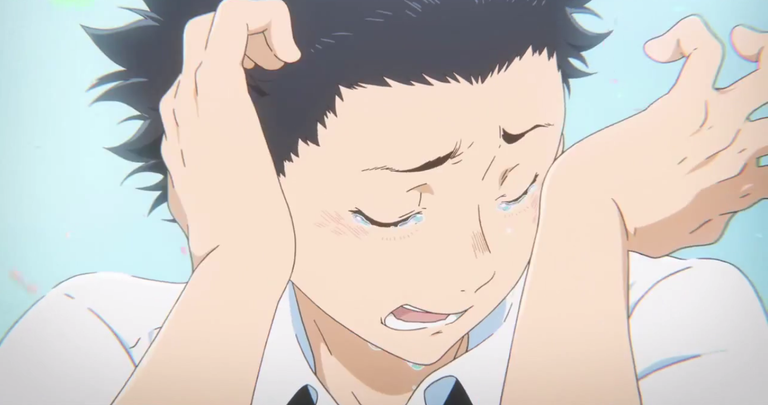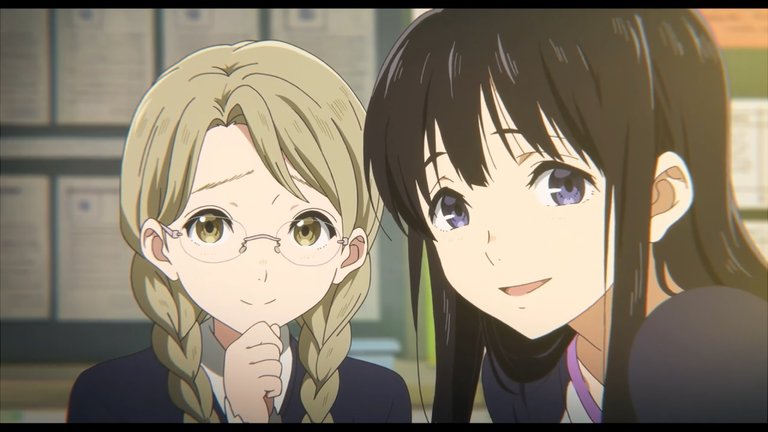If there’s something many writers and directors have aspired to achieve, is that balance between respecting the spectator’s intelligence, and making your message understandable. Make everything too symbolic and cryptic, and nobody will get you (even though this style is also somewhat attractive). Make everything too obvious, tell everything directly, and boredom will be imminent. This is where the famous “Show, don’t tell” comes into play.
I find in “Koe no Katachi” –A Silent Voice in English- the best possible example of the “Show, don’t tell” practice in recent animated movies. I’ll explore many plot points, so if you’re interested in watching this movie, please watch it before reading this analysis. In other words, spoiler warning.
Yoshitoki Ōima’s work, adapted to the cinema by the grand Naoko Yamada, leaves nothing to be desired. It’s got it all. I’ll talk about those details that make Yamada’s adaptation something more than that, and worthy of a full analysis. Let’s talk about subtleties.
Plot, and subtleties
Redemption, depression, suicide, personal acceptance, these are all topics which have been talked about for a long time. But that doesn’t make this movie cliché at all. Let’s see:
Our protagonist is Ishida Shouya, a young male high school student who feels an enormous guilt, because of what he did in the past. This is revealed directly, yet somewhat subtly: In the beginning of the movie he sells his goods, and after leaving all of the money at home, he goes to a bridge planning to just end it all. He would’ve managed to do it, if it wasn’t for some kids playing with fireworks near the river. He then begins to walk and a flashback comes into place, and we get the answers as to why he tried to commit suicide: During elementary school he was kind of a bully, which costed him a lot later on: He had no friends.
Some of his “abuses” were directed towards Shouko. She’s deaf. That led Shouya and others to discover she was using hearing aids, which they later threw and destroyed just for fun. The scene in which Shouya’s mother finds out and takes him to the park in order to apologize is fantastic: Shouya’s mom, after apologizing and giving Shouko’s mother some money, we can briefly see Shouya’s mother saying “Starting tomorrow you’ll be a nice kid”. Yamada does a great job at making this scene the central point for Shouya’s life completely changing. It wasn’t just “I’m good now, hehe, sorry bro”. Shouya sees in his mother’s face a somewhat huge bloodstain, and from this point and on, the guilt takes over him: Shouko’s mom had taken, by force, Ishida’s earrings. His mom was injured, and it was all because of him. What’s interesting about this scene, is the fact that it’s kinda brief, unexpected, and foreshadows what’s about to happen. A couple seconds was enough: Our intelligence is not being underestimated by showing us the blood directly, nor for longer than necessary. No narration telling us what’s happening. No nothing. We’re alone facing this movie, and it’s our job putting the puzzle pieces together in order to understand what’s going on. It’s mostly visuals, and that’s great.
Back to the present, we get to see a friendless, lonely boy with a specially interesting trait: He can’t see people directly, to the face. This psychological trait of him is presented in a simple, visual way: A big “X” covers the face of everyone. We’ll later see the causes of such X’s falling off. The guilt that almost led him to suicide, includes a huge sense of inferiority in the package. Since the very moment he saw his mother’s face partially covered in blood, we could appreciate how in the rest of the flashback he took the bullied kids’ place, and is now a solitary kid. Now in the present, this solitude persists, but differently: It’s not caused by others not wanting to talk to him, but rather by himself. He feels like he’s not worthy of talking to everyone else, he has a big sense of inferiority. He’s been paying the price of his sins for years now, and hasn’t forgiven himself. This matter is specially well presented later on, in the mall scene. After managing to make a friend, Nagatsuka, Shouya asks him about “the meaning of friendship”. What’s the requirement? The simple answer, a hand shake. “This is what being friends means, there are no conditions to meet” is what he says (kind of). This is what I really like about this moment: It’s just not understandable at first glance. A hand shake? What? Shouya doesn’t really get what his friend is trying to tell him, and neither do we. He still feels that powerful inferiority, so we still see every face covered with a big “X” (except for Nagatsuka’s). The solution is there! From such an early moment of the movie! But that earliness is what doesn’t let us fully get the answer, and it wouldn’t be until the end of the movie that we’d comprehend this subtlety, this small detail that solves it all. No one’s superior nor inferior, no distinctions are valid to make a “rights ranking” (not in this era at least). We’re all the same, and there’s no reason to feel we don’t deserve to do something as simple as, in this case, look at people’s faces. It would take the whole film for both Shouya and us to finally understand that this is what Nagatsuka was trying to say. Personal acceptance becomes the most important theme of this movie.
What’s the meaning of true, sincere redemption? Shouya tries to fix his relationship with his deaf childhood classmate, Shouko. His intentions are then questioned by Shouko’s little sister, Yuzuru. She asks him whether he’s doing this because he truly feels regret and wants to fix everything, or just to feel better with himself. What’s his motivation to reenter her sister’s life after so many years? Has he really changed? The answer is presented subtly. With acts, rather than words. First, he learned sign language. If Shouya was doing this just to get such problem out of the shopping list, and wasn’t trying to truly redeem himself, a simple apology would’ve been enough. But he walked the extra mile. The second detail is the presence of the notebook, which he kept for years in order to give it back to Shouko. My favorite subtlety though, is the way Shouya interacts with Yuzuru. She posted some pictures of him falling to a river on the internet, and said pictures caused him some problems. What did Shouya do when he found out? Nothing. In fact, he offered her a roof and some food in his house, since it was raining. He also gave her a pair of shoes. All of that for Yuzuru, the girl that had caused him so many problems. He had indeed changed. We never see him saying “I’ve changed for the better”. Ōima and Yamada leave it all to us.
Romance is not that of a big deal in this story. It’s more than obvious that our protagonists like each other, and Yamada expects us to notice this and move on to what she wants to communicate with her work. There are subtle clues to this fact, like the confession scene. Shouko’s confession becomes a word play because of her deafness. While she wanted to say “Suki” (I like you), her bad pronunciation makes Shouya hear “Tsuki” (Moon) instead. Our confused protagonist is incapable of understanding what Shouko was trying to tell him, but the fact that he thinks so much about what he’s going to tell her, reveals that he shares the feeling. We get to understand that this romance will be taken care of by the characters in the future. But there’s no sight of romantic resolution towards the end of the movie. That’s just not the point of the story, it’s not the topic we’re being communicated by the author.
Later on, Shouya manages to make more friends, and that includes some from the past. The discussion in the bridge takes us through a new “drama” I haven’t yet discussed. Shouko has something in common with Shouya, a strong lack of self-appreciation. We had been hinted at this since the beginning of the movie, with her tendency to apologize every time something went wrong. She feels like everything is her fault, in part because she doesn’t fully understand what’s happening around her (because of her deafness), and in part (and most importantly) because of a simple lack of self-esteem, a somewhat dangerous personality trait. Once more, we understand this thanks to some hints we are beautifully given. Not only is this shown in the flashback, but in the Ferris wheel scene too. Ueno and Shouko both enter this wheel and a zoom-out takes place. Thanks to Yuzuru and her camera, we can see what happened. Ueno (I’ll talk about her later) complains quite a lot. Shouko, unable to fully understand what’s going on, proceeds to apologize. This scene is specially revealing. Even though our deaf friend can’t physically hear what’s going on, she automatically assumes it’s all her fault. Once again, it’s up to us to grasp these details in order to understand Shouko’s personality. No narrators.
Back to the bridge discussion scene. She thinks it’s all her fault, again. This, along with the deep sadness because of her grandmother’s disease (and later death) is enough to make the fireworks come back.
Somehow, fireworks announce suicide in this film. Shouya saw what happened thanks to Yuzuru’s camera, and wanted to make her love herself, have some self-appreciation. He tries to spend more time with Shouko and her sister, by going to the movies and entertainment sites as such. He wasn’t stopped by Shouko’s wishes to step out of his life. They end up in one of those typical Japanese festivals. In the middle of the fireworks, Shouko mysteriously leaves. Her decision had been made: She couldn’t escape Shouya’s determination, so she would kill herself. We already saw what happened: Shouya manages to find her, and in the last moment catches her right in time. But he falls instead.
This is where another sublime writing moment takes place. The same way Shouya’s attitude changed when he saw his mother’s bloody face, Shouya’s fall makes Shouko obtain a completely new perspective on things. She managed to understand that there’s people who care about her, that she’s not disposable, and her mistakes aren’t irreparable. That suicide is in no way the solution to the problems. Shouya’s sacrifice is what makes her understand this. Her guilt has a change in nature: It’s no longer a “depressive” kind of guilt, but rather one which she knows she can work hard to fix things. The guilt no longer comes from the problem at the bridge, but rather the situation Shouya had ended up because of her. We can see this in the scene in which the entire Nishimiya family kneel at Ishida’s feet. A beautifully executed scene. If there was any way to pay him back, it was by filling herself with determination to reunite the group of friends and showing Shouya that mistakes are fixable, and forgiveness exists: That way he would stop feeling inferior to others. By no longer feeling that her disappearance would fix everything, we could say Shouya managed to accomplish his objective, and it was now time for Shouko to do the same thing.
The “Show, don’t tell” stays throughout the entire film as a rule. Shouko’s repeated attempts to talk to Ueno are a simple confirmation of her determination. The scene in which Shouko offers Ueno her umbrella is magnificent: It’s like we’re watching Shouko go through Shouya’s steps when he was kind to Yuzuru, regardless of the problems caused by her.
Speaking about Yuzuru, there’s a subtle yet pretty evident detail in her behavior. The way Yuzuru pays tribute to her deceased grandma by taking her word and worrying more about her studies and herself, is just perfect. I loved the way she said “I’m scared” before attending the funeral, it was just so “human”.
Back to where we were. Shouya wakes up and the school festival takes place. And he has to face everyone once again. The way he couldn’t even see Nagatsuka to the face after what happened at the bridge was heartrending. The hug his friend gives him is the first step towards this movie’s final resolution. When he manages to get out of the bathroom, and meets everyone, he can’t see them to the face. But Shouko’s efforts paid off. The fact that Ueno used hand gestures to tell Shouko she’s an idiot shows Shouya just how much progress had been made, and he notices that everything has changed: They are all getting along very well. They haven’t changed a lot themselves (as stated by Sahara), but the acceptance they show for each other opens our protagonist’s eyes on self-acceptance. They had all committed some kind of mistake, but this didn’t mean they stopped being who they were, and became “less” of a person than others. The big “X” falling off each person’s faces used to signify that Shouya came to trust him/her. But now, the real “X” finally falls off: The one in his mind, the one that made him think his mistakes were irreparable, and blinded him from seeing when his sins were redeemed. He was now with people he could trust, people who liked him and cared for him despite his faults. He finally comes to realize all of this, and that no one is really inferior. He had reached redemption for what he had done in the past a while ago, but only now he came to terms with himself. Shouya is now able to see everyone directly, and when they’re on the school grounds, we can see all the X’s fall off everyone else. He could finally see everyone directly. The way both our protagonists find in the other the support they needed to understand just how much they are worth, is simply excellent.
The beauty with which this moment was crafted, and the way each action fits harmoniously in this movie, made me drop a manly, manly tear. For the millionth time, nothing is revealed directly. It’s up to the spectator to grasp all those subtleties that make this movie a unique piece of art. The way every moment manages to connect the viewer with the situation is strong evidence in favor of Yamada’s excellent work. We’ve all felt like our protagonists at some point. The message this film transmits to all of those who feel this way is, in my opinion, on par with the best of novels and cinematographic works.
Character credibility
I just talked about how “human” it felt when Yuzuru expressed her fear to attend her grandma’s funeral. I loved that moment because it made me believe the character was real. It just feels real. I’ve come to the same conclusion about the rest of the cast. We already analyzed the psychology behind Shouya and Shouko, needless to say I feel like they are truly believable. Nagatsuka feels real too, he maintains a playful and helpful nature throughout the entire movie, can’t complain there. Mashiba’s case is also perfect: He’s a minor character for the development of the plot, so we don’t get to know him very well. That’s not a problem: I don’t want you to give a deep personality and develop unneeded dramas around a character that’s just not that important to the plot. That would be a time waste, the director knows it and keeps things simple.
I would like to talk about Ueno and Kawai a bit more though. Ueno wants Shouya to be the guy he used to be. This is shown by the scene in which she tries to throw Shouko’s hearing aid again, before finding out his friend no longer likes to do that. This is later confirmed by the Ferris wheel scene. She says a friend has been taken from him, and blames Shouko. She wants everything to be the way things used to be, before Shouko ever showed up. She shows a subtle interest in Shouya. Her evolution throughout the movie is very interesting: After showing a hate-able attitude, she’s motivated by Shouko’s insistence and ends up changing a little, this includes her big “X” falling off. She was never an intrinsically bad person, she even accompanied Shouya every day he was asleep, unable to open his eyes. She just used to show some unlikable personality traits, and that, along with everything I just said, makes her believable. Anyone can hate, love, wish to go back, change…it’s just human.
The last character I’d like to talk about is Kawai. Or try. That’s the problem, I can’t “read” her! I can’t simply express this with words. Which are her intentions in every scene she appears in? Is she acting genuinely, or is there are deeper personal interest? Since the flashback scene in which she refused all responsibility on the incident with Shouko (even though she was somewhat guilty, too), going as far as crying to defend herself, I’m just unable to read this character. Was her reaction in the bridge scene sincere? The only moment I can tell she’s acting genuinely, is the scene in which she’s relieved Shouko is alright after attempting suicide. The difficulty I have understanding her is what makes her believable, in my opinion. Admirable writing.
Art style and music
Got no complaints here. The detailed scenarios are a beautiful and significant Kyoto Animation classic. The same way we’re transmitted some visual messages directly (like the huge X’s in people’s faces), the background also has some amazing art that is connected to each scene. Camera angles are also interesting at all times, and camera positioning too. It’s far from the characters when needed, and close when the situation demands it. About the music, same thing. The extremely important music all cinematographic pieces is more than present in Koe no Katachi, and is connected to each moment just right. Can’t give you specific moments, since it’s the whole movie.
That’s my take on Koe no Katachi. A simply beautiful movie, both in plot and execution. Every factor plays in favor of making a film that I’m grateful I watched and enjoyed. I could hardly describe everything I felt while watching it, but that won’t stop me from recommending it without a single doubt. I hope you enjoyed the read! I’d really appreciate your comments, I’m willing to improve :)
All characters and images shown in this post are property of Yoshitoki Ōima and Kyoto Animation
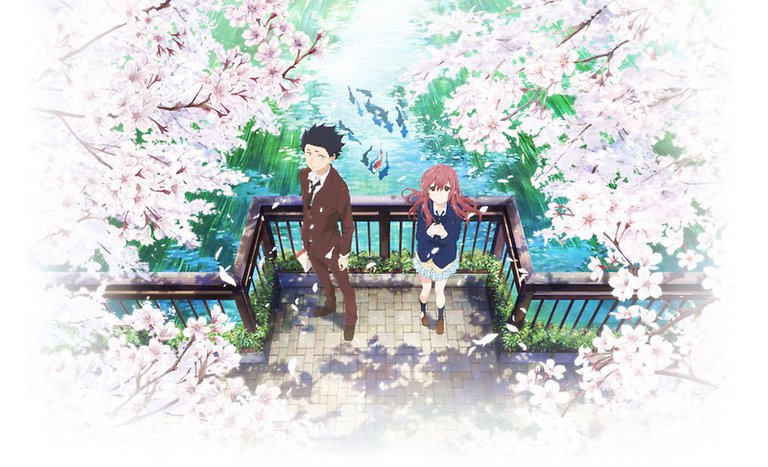

.jpg)
